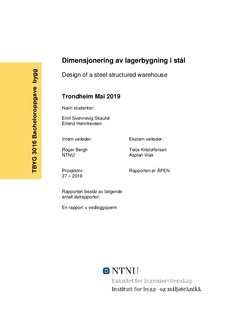| dc.contributor.advisor | Bergh, Roger | |
| dc.contributor.author | Henriksveen, Erlend | |
| dc.contributor.author | Skaufel, Emil | |
| dc.date.accessioned | 2019-08-23T14:09:34Z | |
| dc.date.available | 2019-08-23T14:09:34Z | |
| dc.date.issued | 2019 | |
| dc.identifier.uri | http://hdl.handle.net/11250/2610458 | |
| dc.description.abstract | Bacheloroppgaven omhandler dimensjonering og modellering av en lagerbygning i stål, plassert på Sandmoen i Trondheim.
I oppgaven blir lagerbygningen dimensjonert for opptredende vertikale- og horisontale laster. Stabiliteten til konstruksjonen er et sentralt tema og undersøkes i dybden. Lagerbygningen har en innvendig traverskran med løftekapasitet på 10 tonn. Kranbjelken og konsollen inkluderes i dimensjoneringen.
Konstruksjonen undersøkes for to modeller med ulike randbetingelser. Modellene har derfor ulike behov for horisontal avstivning for å ivareta den globale stabiliteten til konstruksjonen. Følgende modeller innføres for å beskrive randbetingelsene og avstivningssystemene:
Modell A: Leddede søyler og vindkryss som avstivningssystem.
Modell B: Fast innspente søyler og stive rammehjørner. Momentstive rammer benyttes som horisontalavstivning.
Konklusjon:
Ved drøfting av utførelse, økonomi og estetikk, samt stabilitetsanalyse i FEM-design, velges modell A for videre dimensjonering. Modellen kan bygges både billigere og raskere enn modell B, og gir samtidig mindre utbøyinger. Det foreligger ingen konkrete utformingskrav som hindrer bruken av vindkryss.
Konstruksjonen dimensjoners i bruddgrensetilstand og kontrolleres for utbøying i bruksgrensetilstanden. Knutepunktene utføres som sveiste og boltede forbindelser. Oppgaven avrundes med utarbeidelse av detalj- og arbeidstegninger i Revit. | |
| dc.description.abstract | The purpose of this bachelor thesis is to design and model a steel structured warehouse, located at Sandmoen in Trondheim.
The warehouse is designed for the existing vertical and horizontal loads. Global stability analysis is one of the main themes of this thesis and are therefore thoroughly examined.
The warehouse building has an internal traverse crane with a lifting capacity of 10 tonnes.
Two models of the design with identical truss beams, but different boundary conditions are compared in a stability analysis using the FEM-design software. The models have different horizontal stiffening requirements, and the analysis is elucidating the conceptual differences between:
Model A: Pinned columns and with wind braces as horizontal stiffening system.
Model B: Fixed columns with rigid frame corners. Moment resisting frames are used as horizontal stiffening system.
Conclusion:
Model A is selected for further dimensioning based on a comparison of the workmanship required, economy, aesthetics, and the results from the stability analysis in FEM-design of both models. Model A produces smaller deflections and can be built both cheaper and faster than model B. There are no specific design requirements that prevent the usage of wind braces.
The design is further dimensioned in ultimate limit state and then checked for deflection in the serviceability limit state. The crane beam and the console are also included in the dimensioning, as well as four connections on the column.
Preparation of detailed work drawings in Revit concludes the thesis. | |
| dc.language | nob | |
| dc.publisher | NTNU | |
| dc.title | Dimensjonering av lagerbygning i stål | |
| dc.type | Bachelor thesis | |
